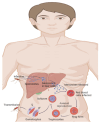Emerging Molecular Mechanisms in Malaria Pathogenesis and Novel Therapeutic Approaches: A Focus on P. falciparum Malaria
- PMID: 40723909
- PMCID: PMC12293666
- DOI: 10.3390/biom15071038
Emerging Molecular Mechanisms in Malaria Pathogenesis and Novel Therapeutic Approaches: A Focus on P. falciparum Malaria
Abstract
Malaria is still one of the biggest global health problems, especially in parts of the world, such as sub-Saharan Africa, which remains most heavily affected. Despite significant advancements in testing, treatment, and prevention, malaria continues to seriously impact millions, primarily young children and populations in rural and impoverished areas. This paper looks at how the malaria parasite works inside the body, how it avoids the immune system, and how it becomes resistant to current drugs. Thanks to new advances in genetic and biochemical research, scientists are discovering new weak points in the parasite that could lead to better treatments. New vaccines, like RTS, S and R21, along with antibody-based therapies, offer renewed hope; however, extending the duration of the immunity they induce and ensuring effectiveness across diverse parasite strains remain significant challenges. Solving the malaria crisis will require more than science-it also necessitates equitable and timely access to treatments, robust health systems, and international collaboration. Continued research and global cooperation bring the world closer to ending malaria for good.
Keywords: elimination; malaria; omics; treatment; vaccine.
Conflict of interest statement
The authors declare no conflicts of interest.
Figures



Similar articles
-
An expanded method for malaria parasite genetic surveillance using targeted nanopore sequencing.Gates Open Res. 2025 Jul 24;9:49. doi: 10.12688/gatesopenres.16355.1. eCollection 2025. Gates Open Res. 2025. PMID: 40718588 Free PMC article.
-
Primaquine or other 8-aminoquinoline for reducing Plasmodium falciparum transmission.Cochrane Database Syst Rev. 2015 Feb 19;(2):CD008152. doi: 10.1002/14651858.CD008152.pub4. Cochrane Database Syst Rev. 2015. Update in: Cochrane Database Syst Rev. 2018 Feb 02;2:CD008152. doi: 10.1002/14651858.CD008152.pub5. PMID: 25693791 Free PMC article. Updated.
-
Primaquine for reducing Plasmodium falciparum transmission.Cochrane Database Syst Rev. 2012 Sep 12;(9):CD008152. doi: 10.1002/14651858.CD008152.pub2. Cochrane Database Syst Rev. 2012. Update in: Cochrane Database Syst Rev. 2014 Jun 30;(6):CD008152. doi: 10.1002/14651858.CD008152.pub3. PMID: 22972117 Updated.
-
Artemisinin-resistant malaria.Clin Microbiol Rev. 2024 Dec 10;37(4):e0010924. doi: 10.1128/cmr.00109-24. Epub 2024 Oct 15. Clin Microbiol Rev. 2024. PMID: 39404268 Review.
-
PfHDAC1 is an essential regulator of P. falciparum asexual proliferation and host cell invasion genes with a dynamic genomic occupancy responsive to artemisinin stress.mBio. 2024 Jun 12;15(6):e0237723. doi: 10.1128/mbio.02377-23. Epub 2024 May 6. mBio. 2024. PMID: 38709067 Free PMC article.
References
-
- WHO Malaria Questions and Answers 4 April 2025. 2025. [(accessed on 6 May 2025)]. Available online: https://www.who.int/news-room/questions-and-answers/item/malaria.
-
- Perdomo Ruiz A.P., Jimenez M., Carrasquilla G. Barriers and facilitators for malaria elimination: A narrative literature review. RESPYN J. Public Health Nutr. 2023;22:26–41. doi: 10.29105/respyn22.2-722. - DOI
-
- WHO World Malaria Report 2023. 2023. [(accessed on 6 May 2025)]. Available online: https://iris.who.int/handle/10665/374472.
Publication types
MeSH terms
Substances
LinkOut - more resources
Full Text Sources

